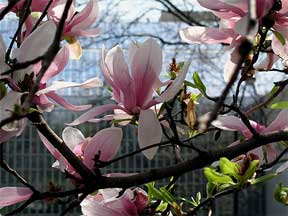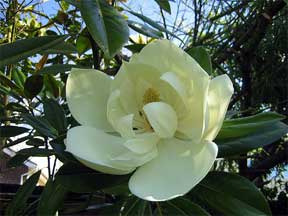Magnolias stand out in the front rank of garden aristocrats but, as in the case of azaleas and others in this select company, there are so many very beautiful kinds that it is not easy to select the best. Some magnolias become medium-sized, others large trees. Many are not reliably hardy. So, the list for spring display in the average garden must be reduced to a smaller, more easily—surveyed group.
The most popular varieties came from a hybrid that was first grown in France and named Magnolia soulangeana to commemorate M. Soulange—Bodin in whose nursery near Paris the hybrid first flowered in 1826. These so-called Saucer Magnolias have large showy flowers mostly white inside and ranging in color outside from pale pink—tinged to deep rose-red. This is why the blooms are most intensely colored in the bud stage. Despite the common name, the flowers rarely open as flat as saucers but remain decidedly cup—shaped, and so the pink and rose—red tones are very effective.
Lenne Magnolia (variety Lennei) is the most intensely colored of this group and seems to have originated from a later and entirely distinct cross of the same parents._The hardiest of all is thought to be Rustica Magnolia (often referred to as Rustica Rubra) , with slightly smaller but deep rose-purple flowers.

As would be expected, these hybrid magnolias do not come true from seed and many inferior plants were distributed in European gardens before it was realized that they should be propagated vegetatively. In our nurseries they are maintained true to type by grafting, layering and rooting cuttings in some cases.
Many admirers find the white-flowering magnolias more beautiful than the colored ones and it is difficult to imagine that any could be lovelier than a fine specimen of Yulan in full bloom. This dominant parent of the Soulange hybrids is a superb plant in its own right with beautifully shaped ivory-white flowers. It is known as Magnolia denudata (also as M. conspicua).
The grace and charm of the Star Magnolia (M. stellata) is well known and it is especially desirable in small gardens because it is compact and bushy in growth and flowers abundantly even when only 2 or 3 feet high. Old specimens finally become tree-like and sometimes exceed 15 feet in height. There are several attractive forms or clones of its variety rosea.
Late frosts often injure the rapidly developing flowerbuds of Star Magnolias and in some sections the similar Kobus Magnolia (M. kobus) proves more satisfactory. It is less compact and bushy, but blooms when small and the pure white 6 to 9-petaled flowers are even more graceful than those of Star Magnolia.
The hybrid between these two species, Magnolia loebneri, seems to have a combination of their good traits, including the greater budhardiness of Kobus. Its flowers have 10 to 14 narrowly obovate petals. While not generally known in this country and apparently not listed in catalogues, it is very likely that this hybrid is more abundant here than we suspect.
Several other early-flowering magnolias deserve more attention, but these and the very charming late. blooming kinds should be studied in botanic gardens and nurseries where their traits can be compared before purchasing. Although valued especially for their bloom, most species are also very attractive in fruit. The cone-like fruit clusters are especially interesting when the large red seeds loosen in their compartments and hang suspended by a white strand of fiber. With such tantalizing delicacies swinging before their eyes, birds are naturalizing some of the exotic kinds just as effectively as they have been disseminating the native Sweet—bay and other indigenous species for centuries.
The composition presented is really a picture frame. It comprises groupings on either side of a vista from the front lawn to the backyard garden. On the right side a single specimen of Saucer Magnolia is placed where it serves as a feature plant at the end of the axis from the terrace, patio or porch. Mass plantings of laurels support it and furnish a low but dense evergreen boundary.
These are purposely not given complete labels in the plan, as this seems a good opportunity for a choice of materials. The groupings could be made with 10 or 11 Mountain-laurels (Kalmialatifolia) which would give a display of pink and white after the magnolias have finished blooming. The optional selection here, especialiy for gardens where winter temperatures do not drop much lower than 10 degrees and that only for brief periods is Cherry-laurel (Prunus laurocerasus).
These evergreen cherries make very handsome leathery-leaved shrubs and one of the upright varieties such as Prunus laurocerasus serbica would be especially appropriate. The Serbian, Cherry-laurel is one of the hardiest kinds. In warmer areas this consideration is not a limiting factor but at the northern end of the range it is.
Three White Pines (Pinus strobus) along the boundary line furnish an introduction to the picture as well as balance the house and add variety with their feathery light green needles.
Alternatives are also offered in the grouping on the left side of the picture. First of all, the Lenne Magnolia is placed at the corner of the house because of its lower and more bushy growth, and also in order that its rich watermelon fragrance can be enjoyed from the terrace. Because of its rosy carmine buds and cup shaped flowers, however, this variety is not appropriate in combinations with other red tones and with yellow.

Should the color of the house be in these categories, it is far better to select the other choice, the Yulan Magnolia with fragrant ivory—white bloom. This species ultimately becomes a tree but, even so, if planted 5 feet from the corner of the house, it will have ample room to adapt itself to the space available. The low shrubs around the base of the magnolia and at the corner of the terrace have been selected for their dense habit and evergreen leaves—Dwarf Yews (Taxus cuspidata nana) for northern gardens, Dwarf Box (Buxus sempervirens suffruticosa) for more southern areas where it thrives, with laurel to furnish the continuity between them and the planting across the grass panel.
Spring The Time for Planting
Spring is the best time to put out all these plants. Magnolias should be transplanted as near as possible to the time when new growth is starting, for then their soft roots can best repair the injuries. Their roots should be disturbed as little as possible and moving with a carefully managed ball of soil is essential.
A deep and moderately rich soil gives best results with magnolias. Heavy soils seem better for their continued well-being than light ones, unless the latter are well enriched. Abundant moisture is also beneficial and abundant sunlight a requisite. As winds damage the large flowers of magnolias, any care taken in selecting protected locations near buildings or windbreaks will be well repaid in fresher and longer-lasting blooms.
Fortunately, at least some magnolias are grown by most nurseries and it is not difficult to find cataloges listing stock of all the kinds mentioned above except Magnolia A loebneri. This fine hybrid masquerades occasionally as Kobus Magnolia and, in fact, the two are so similar in foliage and growth habit that distinction is virtually impossible except from flowers.
by B Blackburn
